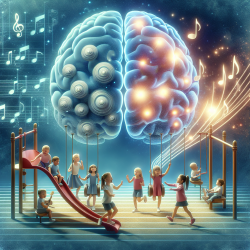Introduction
In the quest to enhance therapeutic outcomes for children, understanding the intricacies of speech auditory brainstem responses (ABR) is crucial. The research article titled "Contribution of Resolved and Unresolved Harmonic Regions to Brainstem Speech-Evoked Responses in Quiet and in Background Noise" offers valuable insights into how these responses function and their potential applications in therapeutic settings.
Understanding Speech ABR
Speech ABR reflects neural activity that is phase-locked to the harmonics of the fundamental frequency (F0) up to at least the first formant (F1). This study explores how resolved and unresolved harmonic regions contribute to speech ABR and their susceptibility to noise. The findings indicate that responses at F0 in the presence of noise are more robust than those at F1, a crucial insight for practitioners working with children who have auditory processing disorders.
Key Findings and Implications
The study found that:
- Responses at F0 are not significantly affected by noise when using stimuli containing all formants or those dominated by resolved harmonics.
- Responses at F0 with stimuli dominated by unresolved harmonics are significantly weaker in noise.
- The response at F1 is more susceptible to noise, highlighting the importance of focusing on F0 responses in noisy environments.
These findings suggest that resolved and unresolved harmonics are processed through different pathways that converge in the upper brainstem. This knowledge can guide practitioners in designing more effective interventions for children with central auditory processing disorders.
Practical Applications for Practitioners
For practitioners, these insights can be transformative. By understanding the differential susceptibility of F0 and F1 responses to noise, speech-language pathologists can tailor their approaches to maximize the effectiveness of interventions. Here are some practical applications:
- Focus on F0 Responses: Given their robustness to noise, interventions can be designed to enhance F0 responses, especially in noisy environments.
- Customized Hearing Aids: Use speech ABR to objectively select and fit modern hearing aids, ensuring they cater to the unique auditory processing needs of each child.
- Early Detection of Disorders: Utilize speech ABR as a marker for central auditory processing disorders, allowing for early intervention and improved outcomes.
Encouraging Further Research
While this study provides significant insights, it also opens the door for further research. Understanding the non-linear interactions between resolved and unresolved harmonics and their precise locus in the brainstem could lead to even more refined therapeutic strategies. Practitioners are encouraged to engage with ongoing research to stay at the forefront of developments in this field.
Conclusion
The potential of speech ABR as a tool for enhancing therapeutic outcomes for children is immense. By leveraging the insights from this research, practitioners can develop data-driven, effective interventions that cater to the unique needs of each child, ultimately leading to better communication and learning outcomes.
To read the original research paper, please follow this link: Contribution of Resolved and Unresolved Harmonic Regions to Brainstem Speech-Evoked Responses in Quiet and in Background Noise.










